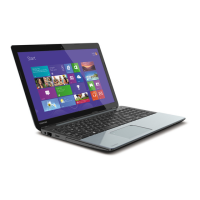
Do you have a question about the Toshiba Satellite S50-B and is the answer not in the manual?
| Operating System | Windows 8.1 |
|---|---|
| RAM | 8GB DDR3L |
| Storage | 1TB HDD |
| Display | 15.6-inch, 1366 x 768 pixels |
| Graphics | AMD Radeon R7 M260 |
| Battery | 4-cell Lithium-ion |
| Weight | 2.08 kg |
| Dimensions | 380 x 259.9 x 19.9 mm |
| Processor | Intel Core i5 or i7 (depending on model) |
Manual ownership, legal disclaimers, and trademark information.
Compliance with regulations like FCC and EU directives.
Licensing details for video encoding/decoding standards.
License terms for OpenSSL toolkit used in the software.
License terms for FreeType font engine.
Information on energy efficiency compliance and features.
Guidelines for proper disposal of electronic waste and batteries.
Safety precautions for operating optical disc drives.
General safety guidelines for operating the computer.
Explanation of safety icons used in the manual.
Items included in the computer package.
Explanation of formatting and terminology used in the manual.
Initial setup and basic usage guide for a new computer.
Procedures for safely shutting down or putting the computer to sleep.
Identification of front components when the display is closed.
Identification of ports and components on the left side of the computer.
Identification of ports and components on the right side of the computer.
Identification of components on the back of the computer.
Identification of components on the underside of the computer.
Identification of front components when the display is open.
Detailed explanation of the computer's internal hardware parts.
Explains computer power status indicators and battery charge.
Instructions on how to use touch screen gestures and functions.
Instructions on how to use touch pad gestures and functions.
Explanation of keyboard layout, special keys, and indicators.
Information on optical drive types, formats, and usage.
Usage limitations and notes for CyberLink PowerDVD software.
Usage limitations and notes for the Blu-ray Disc Player.
How to use 3D playback on external devices and safety warnings.
Details on battery types, usage, charging, and maintenance.
Instructions for connecting and disconnecting to a Local Area Network.
Information on memory card slots, types, and usage.
How to connect and use external displays with the computer.
How to connect and use a security lock to prevent theft.
List of available optional accessories for the computer.
Explains audio controls like Volume Mixer and Microphone Level.
Describes pre-installed utilities and how to start them.
Utility for adjusting display settings like text size and screen resolution.
Utility for setting and managing user and supervisor passwords.
Configuration tool for BIOS and system settings.
Highlights unique or advanced features of TOSHIBA computers.
Information on charging external devices via USB ports, including Sleep and Charge.
Monitors system functions like power, battery, and cooling.
Procedures for creating recovery media and restoring the system.
Guidelines for identifying and resolving computer problems effectively.
Basic checks for common hardware and connection issues.
Steps to analyze issues related to software, hardware, and connections.
Solutions for common issues like unresponsiveness or failure to start.
Troubleshooting guide for various hardware components and peripherals.
Information on how to contact TOSHIBA for technical assistance.
Summarizes the computer's technical specifications and environmental requirements.
Details AC adapter and computer power specifications.
Pinout details for the external RGB monitor port.
Information on power cord compatibility and certification standards.
Details on wireless technology interoperability and safety.
Explanations for non-applicable icons and performance variations.
Definitions of terms used in the manual.
List of abbreviations used throughout the manual.









